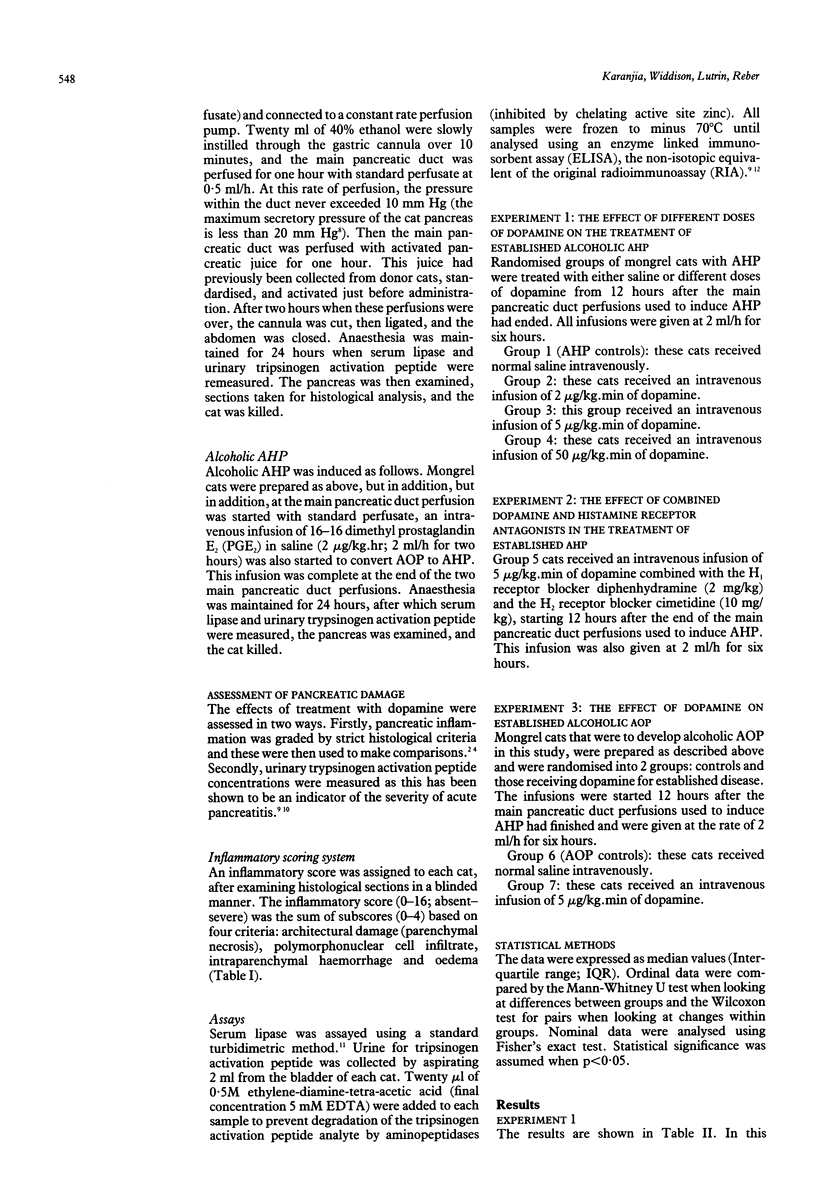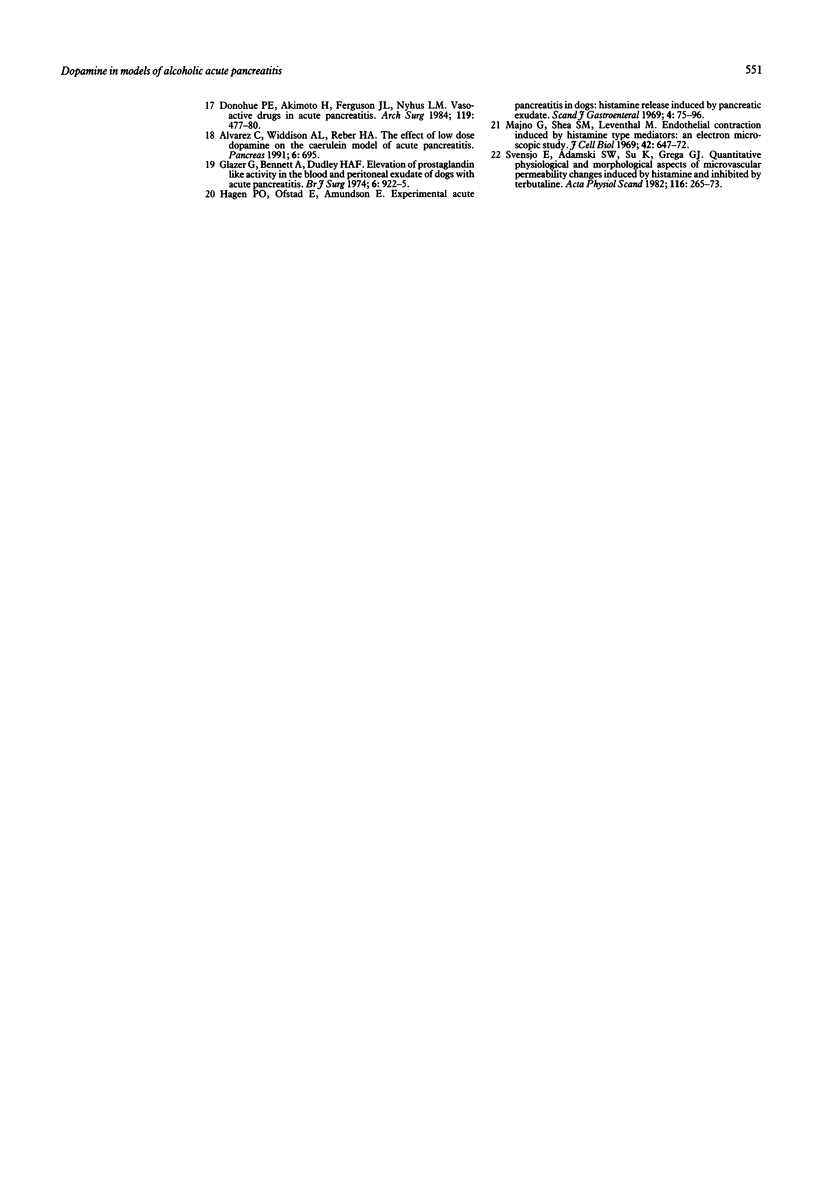Abstract
Acute oedematous pancreatitis and acute haemorrhagic pancreatitis were studied using the low pressure duct perfusion models of alcoholic pancreatitis in cats. After creating either form over 24 hours, each pancreas was histologically graded and assigned an inflammatory score (0-16; absent-severe). Urinary trypsinogen activation peptide concentrations were also used as a measure of severity. Using the model of acute haemorrhagic pancreatitis, it was previously shown that low dose dopamine (5 micrograms/kg.m) reduced the inflammatory score at 24 hours and that this effect was mediated by a reduction in pancreatic microvascular permeability acting via dopaminergic and beta adrenergic receptors. Further studies were conducted and are reported here. In experiment 1 different doses of dopamine in established alcoholic acute haemorrhagic pancreatitis were studied. In group 1 control cats (no dopamine), the inflammatory score was 10.5 (interquartile range (IQR)4). In groups 2, 3, and 4, haemorrhagic pancreatitis was induced. Twelve hours later dopamine was infused for six hours, in the doses of 2 micrograms/kg.min, 5 micrograms/kg.min, and 50 micrograms/kg.min respectively. The inflammatory score in group 2 was 7 (IQR 0.5, p < 0.05 v group 1), in group 3 it was 7 (IQR 2, p < 0.05 v group 1), and in group 4 it was 7 (IQR 4, p < 0.05 v group 1). This was matched by significantly lower levels of urinary tripsinogen activation peptide at 24 hours. In experiment 2 (group 5) we tried to reduce microvascular permeability further by combining dopamine with antihistamines, but there was no improvement in the inflammatory score. As oedematous pancreatitis is the commoner and milder form of acute pancreatitis in clinical practice, in experiment 3 we looked at the effect of dopamine in this model. In group 6 control cats (no treatment), the inflammatory score was 7 (IQR 3, p < 0.05 v group 1). In group 7 cats given dopamine (5 micrograms/kg.min for six hours) from 12 hours after the onset of actue oedematous pancreatitis, the inflammatory score was reduced to 4(IQR 2, p < 0.05 v group 6). This was matched by a significant reduction in the 24 hour urinary tripsin activation peptide concentration.
Full text
PDF




Selected References
These references are in PubMed. This may not be the complete list of references from this article.
- Dasta J. F., Kirby M. G. Pharmacology and therapeutic use of low-dose dopamine. Pharmacotherapy. 1986 Nov-Dec;6(6):304–310. doi: 10.1002/j.1875-9114.1986.tb03492.x. [DOI] [PubMed] [Google Scholar]
- Donahue P. E., Akimoto H., Ferguson J. L., Nyhus L. M. Vasoactive drugs in acute pancreatitis. Arch Surg. 1984 Apr;119(4):477–480. doi: 10.1001/archsurg.1984.01390160103020. [DOI] [PubMed] [Google Scholar]
- Frey C. F. Hemorrhagic pancreatitis. Am J Surg. 1979 May;137(5):616–623. doi: 10.1016/0002-9610(79)90034-5. [DOI] [PubMed] [Google Scholar]
- Harvey M. H., Cates M. C., Reber H. A. Possible mechanisms of acute pancreatitis induced by ethanol. Am J Surg. 1988 Jan;155(1):49–56. doi: 10.1016/s0002-9610(88)80257-5. [DOI] [PubMed] [Google Scholar]
- Hurley P. R., Cook A., Jehanli A., Austen B. M., Hermon-Taylor J. Development of radioimmunoassays for free tetra-L-aspartyl-L-lysine trypsinogen activation peptides (TAP). J Immunol Methods. 1988 Jul 22;111(2):195–203. doi: 10.1016/0022-1759(88)90127-5. [DOI] [PubMed] [Google Scholar]
- Karanjia N. D., Lutrin F. J., Chang Y. B., Reber H. A. Low dose dopamine protects against hemorrhagic pancreatitis in cats. J Surg Res. 1990 May;48(5):440–443. doi: 10.1016/0022-4804(90)90009-q. [DOI] [PubMed] [Google Scholar]
- Karanjia N. D., Widdison A. L., Lutrin F. J., Chang Y. B., Reber H. A. The antiinflammatory effect of dopamine in alcoholic hemorrhagic pancreatitis in cats. Studies on the receptors and mechanisms of action. Gastroenterology. 1991 Dec;101(6):1635–1641. doi: 10.1016/0016-5085(91)90402-7. [DOI] [PubMed] [Google Scholar]
- Kivilaakso E., Fräki O., Nikki P., Lempinen M. Resection of the pancreas for acute fulminant pancreatitis. Surg Gynecol Obstet. 1981 Apr;152(4):493–498. [PubMed] [Google Scholar]
- Lokhandwala M. F., Barrett R. J. Cardiovascular dopamine receptors: physiological, pharmacological and therapeutic implications. J Auton Pharmacol. 1982 Sep;2(3):189–215. doi: 10.1111/j.1474-8673.1982.tb00489.x. [DOI] [PubMed] [Google Scholar]
- Ofstad E., Amundsen E., Hagen P. O. Experimental acute pancreatitis in dogs. II. Histamine release induced by pancreatic exudate. Scand J Gastroenterol. 1969;4(1):75–79. doi: 10.3109/00365526909180153. [DOI] [PubMed] [Google Scholar]
- Reber H. A. Pancreatic duct and microvascular permeability to macromolecules. The relation to acute pancreatitis. Scand J Gastroenterol Suppl. 1985;112:96–100. doi: 10.3109/00365528509092218. [DOI] [PubMed] [Google Scholar]
- Svensjö E., Adamski S. W., Su K., Grega G. J. Quantitative physiological and morphological aspects of microvascular permeability changes induced by histamine and inhibited by terbutaline. Acta Physiol Scand. 1982 Nov;116(3):265–273. doi: 10.1111/j.1748-1716.1982.tb07140.x. [DOI] [PubMed] [Google Scholar]
- VOGEL W. C., ZIEVE L. A rapid and sensitive turbidimetric method for serum lipase based upon differences between the lipases of normal and pancreatitis serum. Clin Chem. 1963 Apr;9:168–181. [PubMed] [Google Scholar]
- Wedgwood K. R., Adler G., Kern H., Reber H. A. Effects of oral agents on pancreatic duct permeability. A model of acute alcoholic pancreatitis. Dig Dis Sci. 1986 Oct;31(10):1081–1088. doi: 10.1007/BF01300261. [DOI] [PubMed] [Google Scholar]
- Wedgwood K. R., Farmer R. C., Reber H. A. A model of hemorrhagic pancreatitis in cats--role of 16,16-dimethyl prostaglandin E2. Gastroenterology. 1986 Jan;90(1):32–39. doi: 10.1016/0016-5085(86)90071-5. [DOI] [PubMed] [Google Scholar]
- de Haën C., Neurath H., Teller D. C. The phylogeny of trypsin-related serine proteases and their zymogens. New methods for the investigation of distant evolutionary relationships. J Mol Biol. 1975 Feb 25;92(2):225–259. doi: 10.1016/0022-2836(75)90225-9. [DOI] [PubMed] [Google Scholar]


